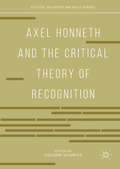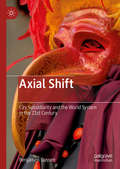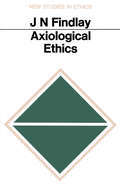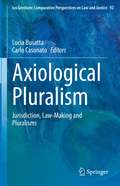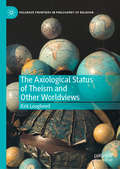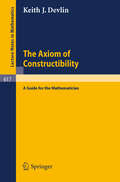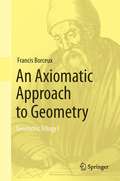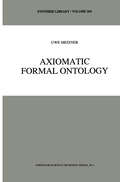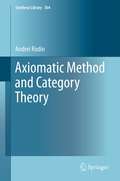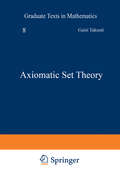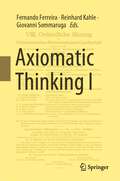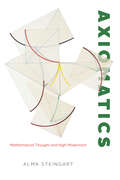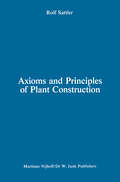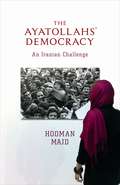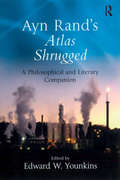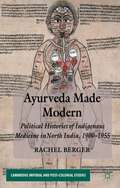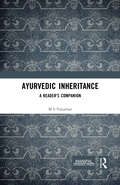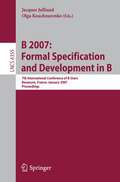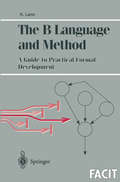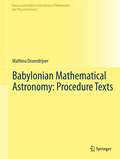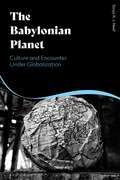- Table View
- List View
Axel Honneth and the Critical Theory of Recognition (Political Philosophy and Public Purpose)
by Volker SchmitzThe critical theory of the Frankfurt School has undergone numerous and at times fundamental changes over the last ninety years. Since the late 1960s, it has been characterized primarily by Jürgen Habermas’s “communicative turn” and a focus on normative foundations. Today, that “second generation” exists side-by-side with a “third generation” represented most prominently by Axel Honneth’s turn toward recognition, ethical life, and the normative reconstruction of social institutions. This volume brings together critical voices on the state and direction of Frankfurt School theory today by examining Honneth’s theory in light of both current challenges and the intellectual and political ambitions that have shaped the tradition from its beginning. United in their strong commitment to critical scholarship, the authors collected here approach Honneth’s work from different backgrounds, employ a wide variety of methodologies, and write in different genres, ranging from the sober scholarly analysis to programmatic and political appeals. The collective aim of these reflections is not to reject Honneth’s theory but to build upon his work and incorporate his themes of recognition and social freedom into a new project of critical theory that can prove adequate to the political and social crises of our time.
Axial Shift: City Subsidiarity and the World System in the 21st Century
by Benjamen GussenThis book uses historical analysis, constitutional economics, and complexity theory to furnish an account of city subsidiarity as a legal, ethical, political, and economic principle. The book contemplates subsidiarity as a constitutional principle, where cities would benefit from much wider local autonomy. Constitutional economics suggests an optimal limit to jurisdictional footprints (territories). This entails preference for political orders where sovereignty is shared between different cities rather states where capital cities dominate. The introduction of city subsidiarity as a constitutional principle holds the key to economic prosperity in a globalizing world. Moreover, insights from complexity theory suggest subsidiarity is the only effective response to the ‘problem of scale.’ It is a fitness trait that prevents highly complex systems from collapsing. The nation-state is a highly complex system within which cities function as ‘attractors.’ The collapse of such systems would ensue if there were strong coupling between attractors. Such coupling obtains under legal monism. Only subsidiarity can make the eventuality of collapse improbable. The emergent and self-organizing properties of subsidiarity entail a shift in policy emphasis towards cities with a wide margin of autonomy.
Axiological Pluralism: Jurisdiction, Law-Making and Pluralisms (Ius Gentium: Comparative Perspectives on Law and Justice #92)
by Lucia Busatta Carlo CasonatoThis book analyses the features and functionality of the relationship between the law, individual or collective values and medical-scientific evidence when they have to be interpreted by judges, courts and para-jurisdictional bodies. The various degrees to which scientific data and moral values have been integrated into the legal discourse reveal the need for a systematic review of the options and solutions that judges have elaborated on. In turn, the book presents a systematic approach, based on a proposed pattern for classifying these various degrees, together with an in-depth analysis of the multi-layered role of jurisdictions and the means available to them for properly handling new legal demands arising in plural societies.The book outlines a model that makes it possible to focus on and address these issues in a sustainable manner, that is, to respond to individual requests and technological advances in the field of biolaw by consistently and effectively applying suitable legal instruments and jurisdictional interpretation.
The Axiological Status of Theism and Other Worldviews (Palgrave Frontiers in Philosophy of Religion)
by Kirk LougheedThis book explores the value impact that theist and other worldviews have on our world and its inhabitants. Providing an extended defense of anti-theism - the view that God’s existence would (or does) actually make the world worse in certain respects - Lougheed explores God’s impact on a broad range of concepts including privacy, understanding, dignity, and sacrifice. The second half of the book is dedicated to the expansion of the current debate beyond monotheism and naturalism, providing an analysis of the axiological status of other worldviews such as pantheism, ultimism, and Buddhism. A lucid exploration of contemporary and relevant questions about the value impact of God’s existence, this book is an invaluable resource for scholars interested in axiological questions in the philosophy of religion.
Axiom of Choice (Lecture Notes in Mathematics #1876)
by Horst HerrlichAC, the axiom of choice, because of its non-constructive character, is the most controversial mathematical axiom. It is shunned by some, used indiscriminately by others. This treatise shows paradigmatically that disasters happen without AC and they happen with AC. Illuminating examples are drawn from diverse areas of mathematics, particularly from general topology, but also from algebra, order theory, elementary analysis, measure theory, game theory, and graph theory.
The Axiom of Constructibility: A Guide for the Mathematician (Lecture Notes in Mathematics #617)
by K. J. DevlinAn Axiomatic Approach to Geometry: Geometric Trilogy I
by Francis BorceuxFocusing methodologically on those historical aspects that are relevant to supporting intuition in axiomatic approaches to geometry, the book develops systematic and modern approaches to the three core aspects of axiomatic geometry: Euclidean, non-Euclidean and projective. Historically, axiomatic geometry marks the origin of formalized mathematical activity. It is in this discipline that most historically famous problems can be found, the solutions of which have led to various presently very active domains of research, especially in algebra. The recognition of the coherence of two-by-two contradictory axiomatic systems for geometry (like one single parallel, no parallel at all, several parallels) has led to the emergence of mathematical theories based on an arbitrary system of axioms, an essential feature of contemporary mathematics.This is a fascinating book for all those who teach or study axiomatic geometry, and who are interested in the history of geometry or who want to see a complete proof of one of the famous problems encountered, but not solved, during their studies: circle squaring, duplication of the cube, trisection of the angle, construction of regular polygons, construction of models of non-Euclidean geometries, etc. It also provides hundreds of figures that support intuition.Through 35 centuries of the history of geometry, discover the birth and follow the evolution of those innovative ideas that allowed humankind to develop so many aspects of contemporary mathematics. Understand the various levels of rigor which successively established themselves through the centuries. Be amazed, as mathematicians of the 19th century were, when observing that both an axiom and its contradiction can be chosen as a valid basis for developing a mathematical theory. Pass through the door of this incredible world of axiomatic mathematical theories!
Axiomatic Formal Ontology (Synthese Library #264)
by Uwe MeixnerAxiomatic Formal Ontology is a fairly comprehensive systematic treatise on general metaphysics. The axiomatic method is applied throughout the book. Its main theme is the construction of a general non-set-theoretical theory of intensional entities. Other important matters discussed are the metaphysics of modality, the nature of actual existence, mereology and the taxonomy of entities.
Axiomatic Method and Category Theory (Synthese Library #364)
by Andrei RodinThis volume explores the many different meanings of the notion of the axiomatic method, offering an insightful historical and philosophical discussion about how these notions changed over the millennia. The author, a well-known philosopher and historian of mathematics, first examines Euclid, who is considered the father of the axiomatic method, before moving onto Hilbert and Lawvere. He then presents a deep textual analysis of each writer and describes how their ideas are different and even how their ideas progressed over time. Next, the book explores category theory and details how it has revolutionized the notion of the axiomatic method. It considers the question of identity/equality in mathematics as well as examines the received theories of mathematical structuralism. In the end, Rodin presents a hypothetical New Axiomatic Method, which establishes closer relationships between mathematics and physics.Lawvere's axiomatization of topos theory and Voevodsky's axiomatization of higher homotopy theory exemplify a new way of axiomatic theory building, which goes beyond the classical Hilbert-style Axiomatic Method. The new notion of Axiomatic Method that emerges in categorical logic opens new possibilities for using this method in physics and other natural sciences.This volume offers readers a coherent look at the past, present and anticipated future of the Axiomatic Method.
Axiomatic Set Theory (Graduate Texts in Mathematics #8)
by G. Takeuti W.M. ZaringThis text deals with three basic techniques for constructing models of Zermelo-Fraenkel set theory: relative constructibility, Cohen's forcing, and Scott-Solovay's method of Boolean valued models. Our main concern will be the development of a unified theory that encompasses these techniques in one comprehensive framework. Consequently we will focus on certain funda mental and intrinsic relations between these methods of model construction. Extensive applications will not be treated here. This text is a continuation of our book, "I ntroduction to Axiomatic Set Theory," Springer-Verlag, 1971; indeed the two texts were originally planned as a single volume. The content of this volume is essentially that of a course taught by the first author at the University of Illinois in the spring of 1969. From the first author's lectures, a first draft was prepared by Klaus Gloede with the assistance of Donald Pelletier and the second author. This draft was then rcvised by the first author assisted by Hisao Tanaka. The introductory material was prepared by the second author who was also responsible for the general style of exposition throughout the text. We have inc1uded in the introductory material al1 the results from Boolean algebra and topology that we need. When notation from our first volume is introduced, it is accompanied with a deflnition, usually in a footnote. Consequently a reader who is familiar with elementary set theory will find this text quite self-contained.
Axiomatic Thinking I
by Fernando Ferreira Reinhard Kahle Giovanni SommarugaIn this two-volume compilation of articles, leading researchers reevaluate the success of Hilbert's axiomatic method, which not only laid the foundations for our understanding of modern mathematics, but also found applications in physics, computer science and elsewhere.The title takes its name from David Hilbert's seminal talk Axiomatisches Denken, given at a meeting of the Swiss Mathematical Society in Zurich in 1917. This marked the beginning of Hilbert's return to his foundational studies, which ultimately resulted in the establishment of proof theory as a new branch in the emerging field of mathematical logic. Hilbert also used the opportunity to bring Paul Bernays back to Göttingen as his main collaborator in foundational studies in the years to come.The contributions are addressed to mathematical and philosophical logicians, but also to philosophers of science as well as physicists and computer scientists with an interest in foundations.Chapter 8 is available open access under a Creative Commons Attribution 4.0 International License via link.springer.com.
Axiomatics: Mathematical Thought and High Modernism
by Alma SteingartThe first history of postwar mathematics, offering a new interpretation of the rise of abstraction and axiomatics in the twentieth century. Why did abstraction dominate American art, social science, and natural science in the mid-twentieth century? Why, despite opposition, did abstraction and theoretical knowledge flourish across a diverse set of intellectual pursuits during the Cold War? In recovering the centrality of abstraction across a range of modernist projects in the United States, Alma Steingart brings mathematics back into the conversation about midcentury American intellectual thought. The expansion of mathematics in the aftermath of World War II, she demonstrates, was characterized by two opposing tendencies: research in pure mathematics became increasingly abstract and rarified, while research in applied mathematics and mathematical applications grew in prominence as new fields like operations research and game theory brought mathematical knowledge to bear on more domains of knowledge. Both were predicated on the same abstractionist conception of mathematics and were rooted in the same approach: modern axiomatics. For American mathematicians, the humanities and the sciences did not compete with one another, but instead were two complementary sides of the same epistemological commitment. Steingart further reveals how this mathematical epistemology influenced the sciences and humanities, particularly the postwar social sciences. As mathematics changed, so did the meaning of mathematization. Axiomatics focuses on American mathematicians during a transformative time, following a series of controversies among mathematicians about the nature of mathematics as a field of study and as a body of knowledge. The ensuing debates offer a window onto the postwar development of mathematics band Cold War epistemology writ large. As Steingart’s history ably demonstrates, mathematics is the social activity in which styles of truth—here, abstraction—become synonymous with ways of knowing.
Axiomatics: Mathematical Thought and High Modernism
by Alma SteingartThe first history of postwar mathematics, offering a new interpretation of the rise of abstraction and axiomatics in the twentieth century. Why did abstraction dominate American art, social science, and natural science in the mid-twentieth century? Why, despite opposition, did abstraction and theoretical knowledge flourish across a diverse set of intellectual pursuits during the Cold War? In recovering the centrality of abstraction across a range of modernist projects in the United States, Alma Steingart brings mathematics back into the conversation about midcentury American intellectual thought. The expansion of mathematics in the aftermath of World War II, she demonstrates, was characterized by two opposing tendencies: research in pure mathematics became increasingly abstract and rarified, while research in applied mathematics and mathematical applications grew in prominence as new fields like operations research and game theory brought mathematical knowledge to bear on more domains of knowledge. Both were predicated on the same abstractionist conception of mathematics and were rooted in the same approach: modern axiomatics. For American mathematicians, the humanities and the sciences did not compete with one another, but instead were two complementary sides of the same epistemological commitment. Steingart further reveals how this mathematical epistemology influenced the sciences and humanities, particularly the postwar social sciences. As mathematics changed, so did the meaning of mathematization. Axiomatics focuses on American mathematicians during a transformative time, following a series of controversies among mathematicians about the nature of mathematics as a field of study and as a body of knowledge. The ensuing debates offer a window onto the postwar development of mathematics band Cold War epistemology writ large. As Steingart’s history ably demonstrates, mathematics is the social activity in which styles of truth—here, abstraction—become synonymous with ways of knowing.
Axioms and Principles of Plant Construction: Proceedings of a symposium held at the International Botanical Congress, Sydney, Australia, August 1981
by R. SattlerThis volume presents the proceedings of a symposium which I organised for the Developmental Section of the Xlllth International Botanical Congress at Sydney, Australia on August 26, 1981. The paper by Professor T. Sachs, which was received too late for inclusion into the symposium at Sydney, was added to these proceedings because of its direct relevancy and importance. The aim of the symposium was to state in an explicit and comprehensive fashion the most basic axioms and principles of plant morphology and morphogenesis. An awareness of these axioms and principles is of paramount importance since they form. the foundations as well as the goal of structural developmental botany. Both teaching and research are predicated on them. The Introduction by the editor briefly examines the meaning of the concepts "axiom", "principle", and "plant construction". The comprehensive paper by Dr. G. Cusset, a unique historical overview, explicates 37 principles of 5 major conceptual systems and many subsystems. The extensive analysis includes a genealogy of ideas and ways of thinking of major authors ranging from philosophers and naturalists of antiquity to recent investigators of plant form and structure. The bibliography of Dr. Cusset I s paper comprises ca. 700 references. The contribution by Professor H. Mohr focusses on modern principles of morphogenesis and provides a penetrating analysis of scientific explanation in developmental biology. The universal principles (laws) described in this paper apply to all living systems, whereas the more specific principles are limited to plants or only higher plants. Professor T.
The Ayatollahs' Democracy: An Iranian Challenge
by Hooman Majd"There are several peculiar features about writing any detailed account of the recent political events in Persia which make necessary some slight explanation. The first point is that Persian political affairs, fraught as they are with misfortune and misery for millions of innocent people, are conducted very much as a well-staged drama - I have heard some critics say, as an opéra bouffe." William Morgan Shuster, "The Strangling of Persia" , 1912So Hooman Majd introduces his story of Iran, with its volatile politics, jostling leaders, global ambitions, and enormous implications for world peace. What does it mean for the world if "Green" represents not a revolution but a civil rights movement, pushing the country toward a particular brand of "Islamic democracy"? And how will Iran's diversity of political positions, so often sidelined in news reporting, ultimately resolve itself? With witty, candid, and stylishly-intelligent reporting, Hooman Majd introduces top-level politicians and clerics alongside regular Iranians, including Jewish community leaders. A personal, candid tour of the political and social landscape in Iran, The Ayatollahs' Democracy is a powerful dispatch from a country at a historic turning point.
Ayn Rand's Atlas Shrugged: A Philosophical and Literary Companion
by Edward W. YounkinsSince its publication in 1957 Atlas Shrugged, the philosophical and artistic climax of Ayn Rand's novels, has never been out of print and has received enormous critical attention becoming one of the most influential books ever published, impacting on a variety of disciplines including philosophy, literature, economics, business, and political science among others. More than a great novel, Atlas Shrugged is an abstract conceptual, and symbolic work that expounds a radical philosophy, presenting a view of man and man's relationship to existence and manifesting the essentials of an entire philosophical system - metaphysics, epistemology, politics and ethics. Celebrating the fiftieth year of Atlas Shrugged's publication, this companion is an exploration of this monumental work of literature. Contributions have been specially commissioned from a diversity of eminent scholars who admire and have been influenced by the book, the included essays analyzing the novel's integrating elements of theme, plot and characterization from many perspectives and from various levels of meaning.
Ayn Rand's Atlas Shrugged: A Philosophical and Literary Companion
by Edward W. YounkinsSince its publication in 1957 Atlas Shrugged, the philosophical and artistic climax of Ayn Rand's novels, has never been out of print and has received enormous critical attention becoming one of the most influential books ever published, impacting on a variety of disciplines including philosophy, literature, economics, business, and political science among others. More than a great novel, Atlas Shrugged is an abstract conceptual, and symbolic work that expounds a radical philosophy, presenting a view of man and man's relationship to existence and manifesting the essentials of an entire philosophical system - metaphysics, epistemology, politics and ethics. Celebrating the fiftieth year of Atlas Shrugged's publication, this companion is an exploration of this monumental work of literature. Contributions have been specially commissioned from a diversity of eminent scholars who admire and have been influenced by the book, the included essays analyzing the novel's integrating elements of theme, plot and characterization from many perspectives and from various levels of meaning.
Ayurveda Made Modern: Political Histories of Indigenous Medicine in North India, 1900-1955 (Cambridge Imperial and Post-Colonial Studies)
by R. BergerThis book explores the ways in which Ayurveda, the oldest medical tradition of the Indian subcontinent, was transformed from a composite of 'ancient' medical knowledge into a 'modern' medical system, suited to the demands posed by apparatuses of health developed in late colonial India.
Ayurvedic Inheritance: A Reader's Companion
by M S ValiathanThis book is a companion to Āyurvedic studies. It discusses the history and evolution of Ayurveda, its philosophy, and its practical uses in everyday life—from medicine to mental wellbeing. It harks back to the traditional Indian concept of four aspects of lifelong learning. These were instruction by the teacher, individual effort, learning from companions and lastly, wisdom gathered over a lifetime. Print edition not for sale in South Asia (India, Sri Lanka, Nepal, Bangladesh, Pakistan and Bhutan)
Ayurvedic Inheritance: A Reader's Companion
by M S ValiathanThis book is a companion to Āyurvedic studies. It discusses the history and evolution of Ayurveda, its philosophy, and its practical uses in everyday life—from medicine to mental wellbeing. It harks back to the traditional Indian concept of four aspects of lifelong learning. These were instruction by the teacher, individual effort, learning from companions and lastly, wisdom gathered over a lifetime. Print edition not for sale in South Asia (India, Sri Lanka, Nepal, Bangladesh, Pakistan and Bhutan)
B 2007: 7th International Conference of B Users, Besancon, France, January 7-19, 2007, Proceedings (Lecture Notes in Computer Science #4355)
by Jacques Julliand Olga KouchnarenkoThis book constitutes the refereed proceedings of the 7th International Conference of B Users, B 2007, held in Besançon, France, January 2007. Coverage in this volume includes industrial applications and case studies using B, integration of model-based specification methods in the software development lifecycle, derivation of hardware-software architecture from model-based specifications, and validating requirements through formal models.
The B Language and Method: A Guide to Practical Formal Development (Formal Approaches to Computing and Information Technology (FACIT))
by Kevin LanoB is one of the few formal methods which has robust, commercially-available tool support for the entire development lifecycle from specification through to code generation. This volume provides a comprehensive introduction to the B Abstract Machine Notation, and to how it can be used to support formal specification and development of high integrity systems. A strong emphasis is placed on the use of B in the context of existing software development methods, including object-oriented analysis and design. The text includes a large number of worked examples, graduated exercises in B AMN specification and development (all of which have been class-tested), two extended case studies of the development process, and an appendix of proof techniques suitable for B. Based on material which has been used to teach B at postgraduate and undergraduate level, this volume will provide invaluable reading a wide range of people, including students, project technical managers and workers, and researchers with an interest in methods integration and B semantics.
Babylonian Mathematical Astronomy: Procedure Texts (Sources and Studies in the History of Mathematics and Physical Sciences)
by Mathieu OssendrijverThis book contains new translations and a new analysis of the procedure texts of Babylonian mathematical astronomy, the earliest known form of mathematical astronomy of the ancient world. The translations are based on a modern approach incorporating recent insights from Assyriology and translation science. The work contains updated and expanded interpretations of the astronomical algorithms and investigations of previously ignored linguistic, mathematical and other aspects of the procedure texts. Special attention is paid to issues of mathematical representation and over 100 photos of cuneiform tablets dating from 350-50 BCE are presented.In 2-3 years, the author intends to continue his study of Babylonian mathematical astronomy with a new publication which will contain new editions and reconstructions of approx. 250 tabular texts and a new philological, astronomical and mathematical analysis of these texts. Tabular texts are end products of Babylonian math astronomy, computed with algorithms that are formulated in the present volume, Procedure Texts.
The Babylonian Planet: Culture and Encounter Under Globalization
by Sonja NeefWhat is astro-culture? In The Babylonian Planet it is unfolded as an aesthetic, an idea, a field of study, a position, and a practice. It helps to engineer the shift from a world view that is segregated to one that is integrated – from global to planetary; from distance to intimacy and where closeness and cosmic distance live side-by-side. In this tour de force, Sonja Neef takes her cue from Edouard Glissant's vision of multilingualism and reignites the myth of the Tower of Babel to anticipate new forms of cultural encounter. For her, Babel is an organic construction site at which she fuses theoretical analysis and case studies of artists, writers and thinkers like William Kentridge, Orhan Pamuk and Immanuel Kant. Her skilful interrogations then allow her to paint a portrait of art and culture that abolishes the horizon as a barrier to vision and reclaims it as a place of contact and relation. By combining the Babylonian concept of the encounter and the planetary concept of the whole-earth, Neef creates a space – an astro-culture – in which she can examine topics as varied as language, translation, media, modernity, migration and the moon. In doing so, she instigates a renewed cultural understanding receptive to the kinder forms of cultural encounter and globalisation she hopes will come.
